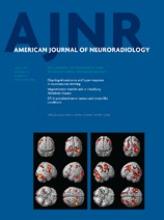Abstract
BACKGROUND AND PURPOSE: There is significant interest in whether diffusion-weighted MR imaging indices, such as the minimum apparent diffusion coefficient, may be useful clinically for preoperative tumor grading and treatment planning. To help establish the pathologic correlate of minimum ADC, we undertook a study investigating the relationship between minimum ADC and maximum FDOPA PET uptake in patients with newly diagnosed glioblastoma multiforme.
MATERIALS AND METHODS: MR imaging and FDOPA PET data were acquired preoperatively from 15 patients who were subsequently diagnosed with high-grade brain tumor (WHO grade III or IV) by histopathologic analysis. ADC and SUVR normalized FDOPA PET maps were registered to the corresponding CE MR imaging. Regions of minimum ADC within the FDOPA-defined tumor volume were anatomically correlated with areas of maximum FDOPA SUVR uptake.
RESULTS: Minimal anatomic overlap was found between regions exhibiting minimum ADC (a putative marker of tumor cellularity) and maximum FDOPA SUVR uptake (a marker of tumor infiltration and proliferation). FDOPA SUVR measures for tumoral regions exhibiting minimum ADC (1.36 ± 0.22) were significantly reduced compared with those with maximum FDOPA uptake (2.45 ± 0.88, P = .0001).
CONCLUSIONS: There was a poor correlation between minimum ADC and the most viable/aggressive component of high-grade gliomas. This study suggests that other factors, such as tissue compression and ischemia, may be contributing to restricted diffusion in GBM. Caution should be exercised in the clinical use of minimum ADC as a marker of tumor grade and the use of this index for guiding tumor biopsies preoperatively.
ABBREVIATIONS:
- CE
- contrast-enhanced
- FDOPA
- 3,4-dihydroxy-6-[18F]-fluoro-L-phenylalanine
- GBM
- glioblastoma multiforme
- SUVR
- standardized uptake value ratio
- WHO
- World Health Organization
- © 2013 by American Journal of Neuroradiology
Indicates open access to non-subscribers at www.ajnr.org












